Last Chance to Catch NYC's Holiday Notalgia Train
We met the voices of the NYC subway on our nostalgia ride this weekend!


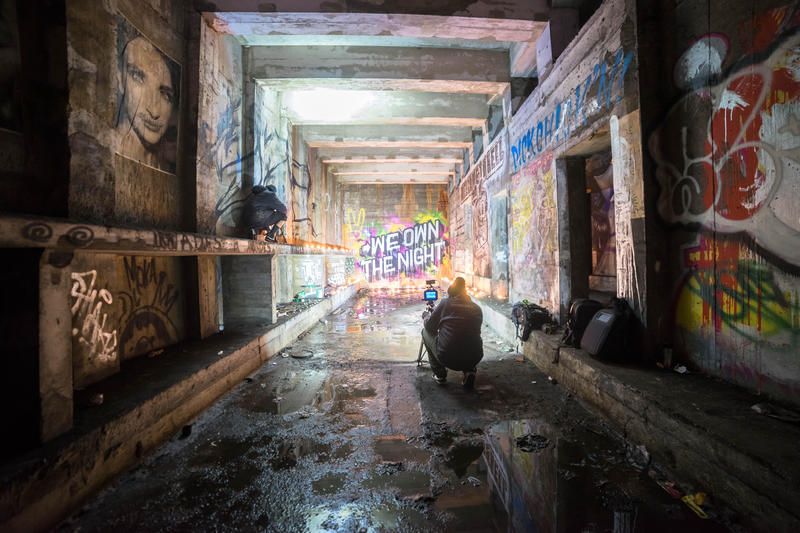
From pieces commissioned by MTA Arts and Design to original decorative tiles in the very first subway stations and guerilla art projects that pop up every now and then, the New York City subway system is full of art. While most subway art is easily accessible, there have been art installations in abandoned subway spaces that would have been illegal and dangerous to view. In our upcoming virtual talk on abandoned subway stations, you can relive some of these installations from the safety and comfort of your home as Untapped New York’s Chief Experience Officer Justin Rivers and our Artist-in-Residence Aaron Asis guide you through the many neglected spaces below New York City’s streets. Keep reading to discover seven art installations in abandoned subway stations!
The Masstransiscope is a unique art project originally created by Bill Brand in 1980. It is located inside the abandoned Myrtle Ave subway station that used to be part of the Brooklyn-Manhattan Transit line between Manhattan Bridge and DeKalb Avenue. When the line in that area of Brooklyn was rebuilt, the Myrtle Avenue station lost its southbound platform and the northbound platform was closed off.

Abandoned Subway Stations
The Masstransiscope is a giant zoetrope, an early form of animation that pre-dates film. It creates the illusion of motion with a sequence of images that show progressive stages of motion. Brand’s zoetrope is made up of 228 colorful hand-painted images that appear to move as the subway train rides along the sequence. The piece was restored in 2008 and 2013. You can watch the 20-second sequence as you travel on a northbound express train from the DeKalb Avenue station.
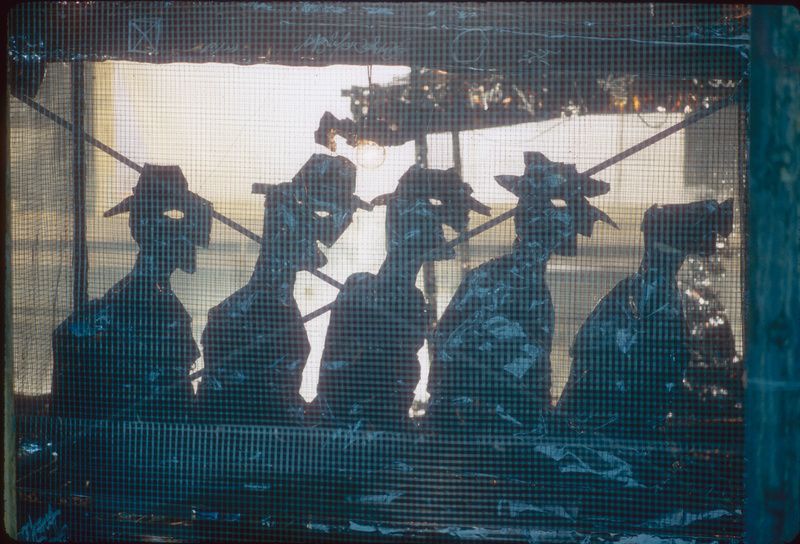
An abandoned track at the Canal Street station on the J/Z line was transformed into a Venetian canal by the work of Russian-born artist Alexander Brodsky in 1996. Brodsky created gondola and people-shaped shadow puppets out of tin and wooden cutouts. Lights, soft music, and the sound of lapping water all enhanced the illusion as the cutouts bobbed up and down in shallow tanks of water.
Behind the cutouts, a perspective drawing of an ancient Venetian street further added to the effect. Brodsky described his piece as “one of the millions of strange things that happen to you in this city.” The art installation brought some life into an otherwise dead area of the subway station that riders had to pass through. “You stop for a few minutes trying to understand what it is and why it is here and then you go on with your life, keeping the mirage in your memory, said Brodsky, “You might come back another day to check—was it a dream or not?”

In 2009, street artists PAC and Workhorse invited 103 street artists to create original works of art inside the abandoned 6-track station underneath Williamsburg at South 4th Street. The station was built as part of the IND line, but it was never opened. Over the course of the year, each artist was given one night to complete their work. Renowned street artists from around the world were involved with this project, at great risk. Street artist Banksy was invited, but sadly had to turn down the offer work on his own film.
The Underbelly Project was never meant for an audience. Due to its inaccessible location, the project was create by the artists and for the artists, not for curators or gallerists, or collectors. The incredible works of art were documented by urban explorer @vic.invades and have since been closed off.
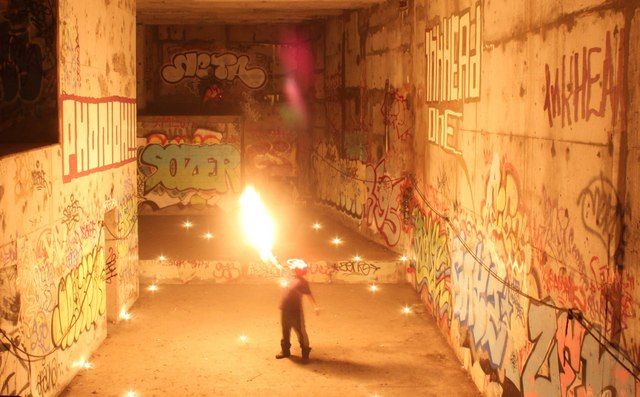
The location of the Echo Vault is not openly shared, though it is known among intrepid urban explorers. The cavernous space surrounded by staircases and abandoned track lines served as a performance space for one special night in 2013. On the summer solstice, a group of 200 revelers were led into the abandoned space by Wanderlust Projects, the group responsible for producing the Night Heron Speakeasy in a watertower.
Guests were encouraged to wear comfortable shoes, bring a flashlight, and told not to blog or post about the clandestine party. Everyone had to accept the risks associated with attending this once-in-a-lifetime affair. After descending a series of ladders and stairs, guests wandered through empty graffiti-tagged chambers and enjoyed a performance by the Extra Action Marching Band. Gothamist writer John Del Signore described the event as an “exorcism disguised as a dance party.”
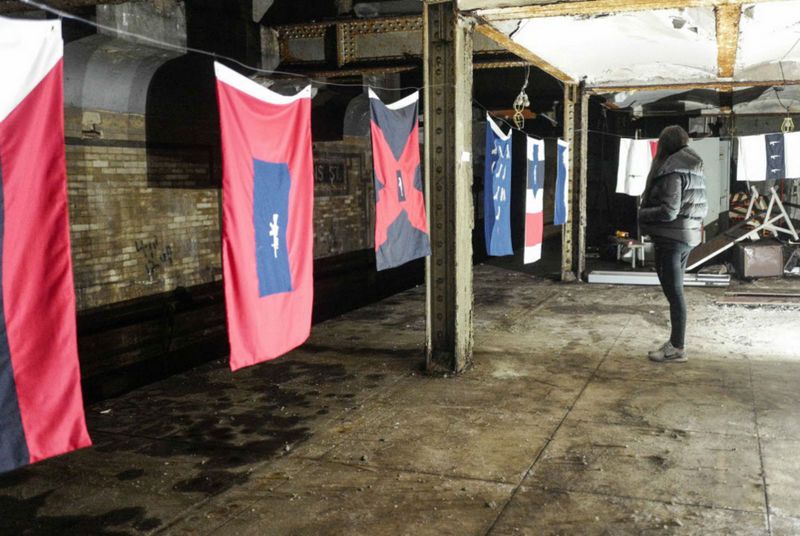
Gaining access to a guerilla exhibition installed at the abandoned Nevins Street subway station in Brooklyn in 2016 posed a risk of death. The only way to access the platform was to find the right time between trains to run along the active tracks between the Nevins and Hoyt Street stations, while avoiding the electrified third rail, an action that is highly discouraged, and illegal.
If you made it safely onto the lower level of the Nevins Street station, you would have seen an arrangement of ten different flags. The flags each represented a mass shooting in America, from Columbine to Sandy Hook and San Bernadino. The design of each flag featured a different gun used in that shooting. The artist behind the exhibition, titled The Perilous Fight, was Phil America, an activist and author of the books Above The Law Volume I: Graffiti on Passenger Trains and Our Side of the Tracks. “For me, it’s about doing good work, not showing in the spaces that already exist,” he said.
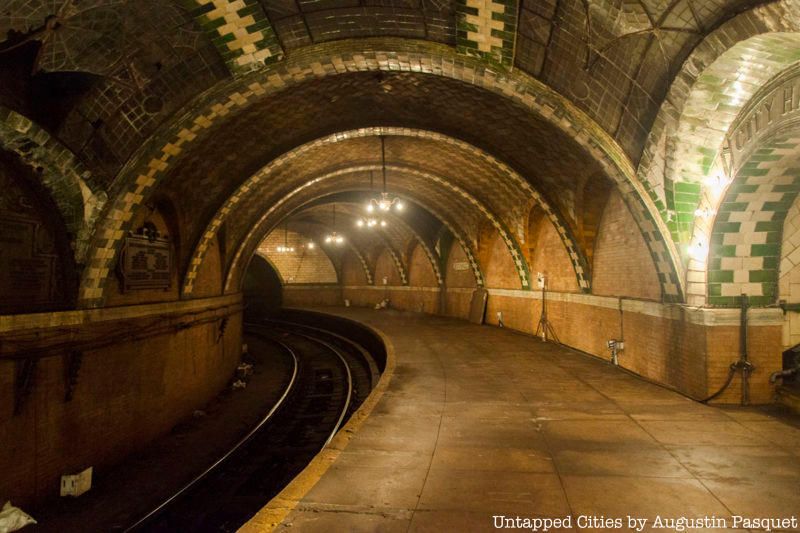
The famously abandoned City Hall Station in Lower Manhattan was once considered the crown jewel of the New York City subway system, and it’s easy to see why. Built into the station are thirteen Guastavino arches ornamented with green and cream-colored terra-cotta tiles that contrast the red brick walls and ornate blue skylights. The skylights and arches, while decorative, also served a practical purpose. Since this was the very first subway station, the arches and skylights helped make it feel larger and airier, so hesitant riders would feel comfortable traveling underground.
The 400-foot-long station was designed by the famous architect duo of Heins and LaFarge. All of the stations in the Interborough Rapid Transit Company designed by the pair featured beautiful flourished, though none were as grand as City Hall. City Hall Station was shut down in 1945, but if you stay on the 6 train past the last stop, you can see it from the window of your subway car as the train turns around in the abandoned station. Join us on our upcoming underground tour of the subway to try it for yourself!
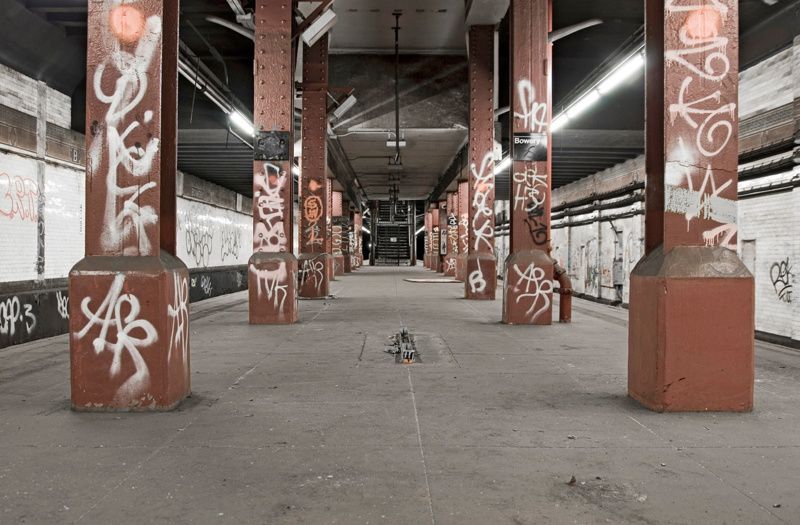
The abandoned portion of the Bowery Station on the J/Z line has made the news for a variety of special projects. In 2015, graffiti artist VEW made headlines for his Star Wars themed anti-Isis mural painted on the wall of the abandoned station. That same year, the NYPD used the abandoned space for a counter-terrorism training drill.
The Bowery subway station is often used in movies and television series as a filming location. You can spot it in USA’s series Mr. Robot and the Amazon Prime show Hunters with Al Pacino. Most recently, the station was activated for a fashion show. In 2019, Tom Ford unveiled his 2020 collection in the graffiti and grime-filled space.

Abandoned Subway Stations
Continue to explore the forgotten areas of the NYC subway system on our upcoming virtual tour of abandoned subway stations! Tickets to this talk on March 24th are just $10. You can gain access to unlimited free virtual events per month and unlock a video archive of 100+ past events as an Untapped New York Insider starting at $10/month. Already an Insider? Register here! Can’t make it live? Register for this virtual talk and we’ll email you a recording of it after it ends!
Next, check out 20 of NYC’s Abandoned Subway Stations, Levels and Platforms
Subscribe to our newsletter